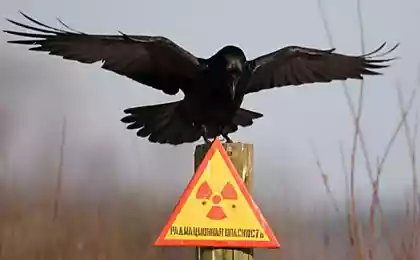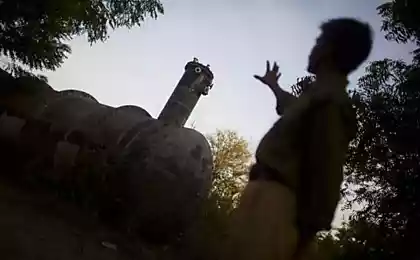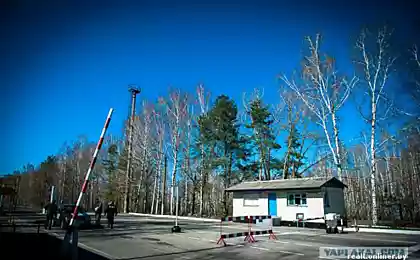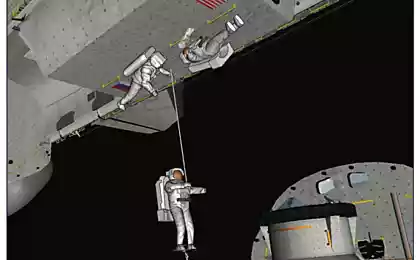1115
Future Accidents

1. New Ocean
~ 10 million years
One of the hottest places on earth, the Afar depression - is between Ethiopia and Eritrea - an average of 100 meters below sea level. At this point between the surface and the boiling hot magma is just 20 km away, and the land slowly becomes thinner due to tectonic movements. Including suicidal arrays of volcanoes, geysers, earthquakes and toxic hot water basin is unlikely to be the resort; but after 10 million years, when the geological activity ceases, leaving only a dry swimming pool, this place will eventually fill with water and form a new ocean - the perfect place for water skiing in the summer.
2. Event huge influence on the Earth
~ 100 million years
Given the rich history of the Earth and the relatively large number of disordered fragments circulating in the space of a threat to the planet, scientists are predicting that in the next 100 million years the Earth has experienced the impact of an event comparable to the event that caused the Cretaceous-Paleogene extinction 65 million years ago. This, of course, is bad news for all life on Earth. Although some species, no doubt survive this impact is likely to mean the end of the era of mammals - the current Cenozoic era - and, instead, the Earth will enter a new era of complex life forms. Who knows what life will flourish on this earth has recently refined? Maybe one day we will share the universe with intelligent invertebrates and amphibians. At this point, we can only imagine what will happen.
3. Pangaea Ultima
~ 250 million years
Over the next 50 million years Africa, which migrates to the north over the last 40 million years, in the end, will begin to encounter southern Europe. This movement will seal the Mediterranean Sea for 100 million years, and will create thousands of new kilometers of mountain ranges to the joy of climbers from all over the world. Australia and Antarctica are also seeking to be a part of this new supercontinent, and will continue its movement north to merge with Asia. While all this happens, America will continue its course to the west, farther away from Europe and Africa to Asia.
What happens next, still under discussion. It is believed that while the Atlantic is growing, on the western border is formed subduction zone, which will stretch from the bottom of the Atlantic Ocean deep into the earth. This effectively changes the direction in which America is moving, and in the end, bring it to the eastern boundary of the Eurasian supercontinent for about 250 million years. If it does not, we can expect that the Americas will continue its way to the west until you merge with Asia. In any case, we can expect the formation of a new giperkontinenta: Pangaea Ultima - over 500 million years after the last of the continent, Pangaea. After that, it will probably be divided again and start a new cycle of drift and mergers.
4. Splash gamma rays
~ 600 million years
If the event is a huge influence on the Earth, repeated every few hundred million years, you think not the worst option, then know that the earth is constantly having to deal with the rare gamma-ray bursts - the flow of ultra-high-energy radiation typically emitted by supernovae. Despite the fact that we are weak gamma-ray bursts every day, an explosion occurring in a neighboring solar system - within 6500 light years from us - has the potential to wreak havoc on its way.
With more energy than the Sun has produced over the entire life cycle, which hit the Earth in minutes or even seconds, gamma rays will burn most of the Earth's ozone layer, causing drastic changes in climate and extensive environmental damage, including mass extinction.
Some believe that this surge of gamma rays triggered the second largest mass extinction in history: the Ordovician-Silurian extinction events 450 million years ago, which destroyed 60% of all life on Earth.
Like all events in astronomy, the exact time for a set of events that provoke aimed at Earth gamma-ray burst, very difficult to predict, although it estimates a typical period is 0, 5-2 billion years. But this time may be reduced up to a million years, if the threat nebula Eta Carinae will be realized.
5. uninhabitable
~ 1.5 billion years
Since the Sun is getting hotter by the increase in the size of Earth, eventually cease to be habitable - because of the proximity to the hot sun. By this time, everything, even the most stable forms of life on Earth will perish. Oceans are completely dry, leaving only the burnt desert land. Time is running out and the temperature rises, the Earth can take the path of Venus and turn into a toxic wasteland, as heated to the boiling point of many toxic metals. What's left of humanity, it should be free a place to survive. Fortunately, by the time Mars will enter the habitable zone, and can serve as a temporary shelter for the remaining people.
6. The disappearance of the magnetic field
~ 2.5 billion years
Some believe, based on current understanding of the Earth's core, which for 2, 5 billion. Years of Earth's outer core is no longer liquid, and will start to freeze. Since the core cools, the magnetic field of the Earth will slowly fade until it ceases to exist at all. In the absence of a magnetic field, there will be nothing to protect the Earth from the solar wind and the Earth's atmosphere will gradually lose its light compounds - such as ozone - and gradually become a pitiful remains of itself. Now, with an atmosphere similar to a Venusian, the Earth will feel the full force of the solar radiation that will make already inhospitable land, even more insidious.
7. The inner solar system catastrophe
~ 3.5 billion years
After about 3 billion years, there is a small but significant chance that Mercury's orbit will be extended in a way that crosses the path of Venus. At this point we can not predict exactly what will happen and when it will happen, but at best a Mercury will be absorbed by the Sun or destroyed in a collision with his older sister Venus. In the worst case? Earth may encounter with any other of the non-gaseous planets whose orbits are radically destabilized Mercury. If somehow the inner solar system will remain intact and will continue to run smoothly, within five billion years of Mars's orbit intersects the Earth, again making it possible to disaster.
8. A new picture of the night sky
~ 4 billion years
Years later, all life on Earth will be a pleasure to watch the steady growth of the Andromeda galaxy in the picture of our starry sky. This is truly a magnificent sight to see the full majesty perfectly formed spiral galaxy, glowing in the sky, but it will not last forever. Over time, it will begin to badly distort and merge with the Milky Way, plunging stable star arena into chaos. Despite the fact that the direct collision of celestial bodies is unlikely, there is little chance that our solar system may be removed and thrown into the abyss of the universe. In any case, our night sky would be, at least temporarily, is decorated with trillions of new stars
9. A ring of debris
~ 5 billion years
Despite the fact that the moon is constantly retreating to a distance of 4 cm a year, the Sun entered the red giant phase, and it is likely that the current trend will stop. An additional force acting on the Moon by the huge bloated star, will be enough to bring down the moon directly at Earth. When the moon reaches the Roche limit, it starts to disintegrate, as the force of gravity exceeds the force holding the moon in integrity. After that, perhaps around the Earth formed a ring of debris, showing any life on earth a beautiful view until the trash falls to the ground after many millions of years.
If this does not happen, there is another way in which the moon may fall back to the parent planet. If Earth and the Moon will continue to exist in their current form with their constant orbits, approximately 50 billion years, the Earth will become tidally locked with the Moon. Shortly after this event, the height of the Moon's orbit begins to decay, while the speed of rotation of the Earth will grow rapidly. This process will continue until the moon reaches the Roche limit and fall apart, forming a ring around the Earth.
10. Destruction
Unknown
The likelihood that the earth will collapse within the next ten billion years is very high. In cold Do insidious grip of the planet, or by suffocation in the arms of our dying sun, it would surely be a sad moment for all the survivors - even if they do not remember what a planet is.























